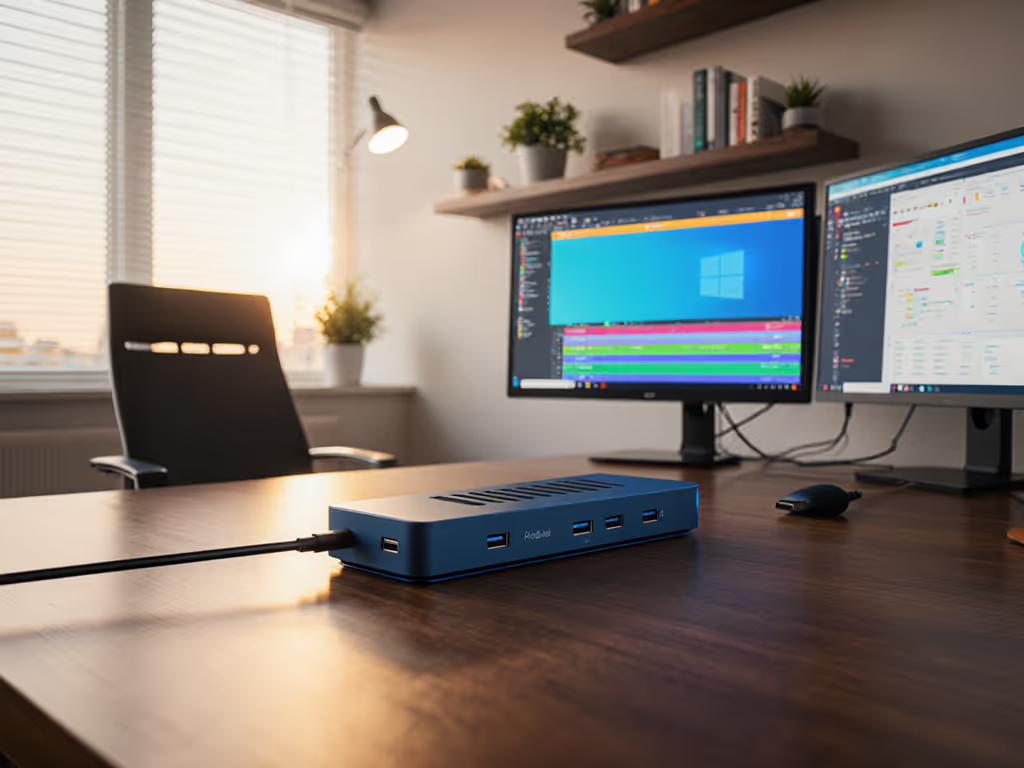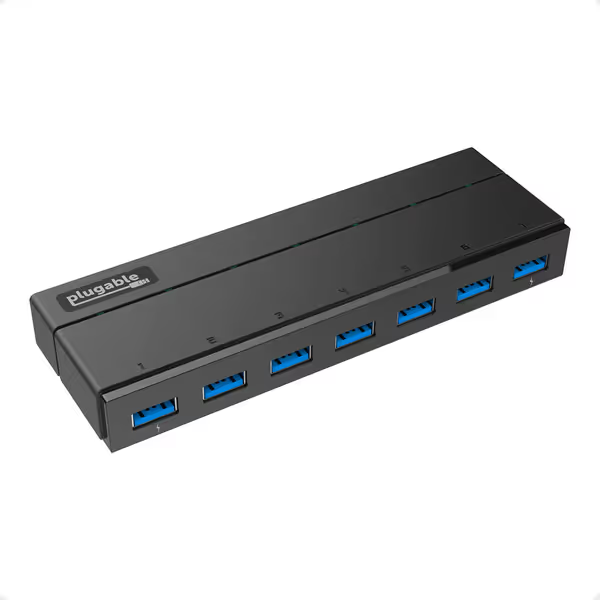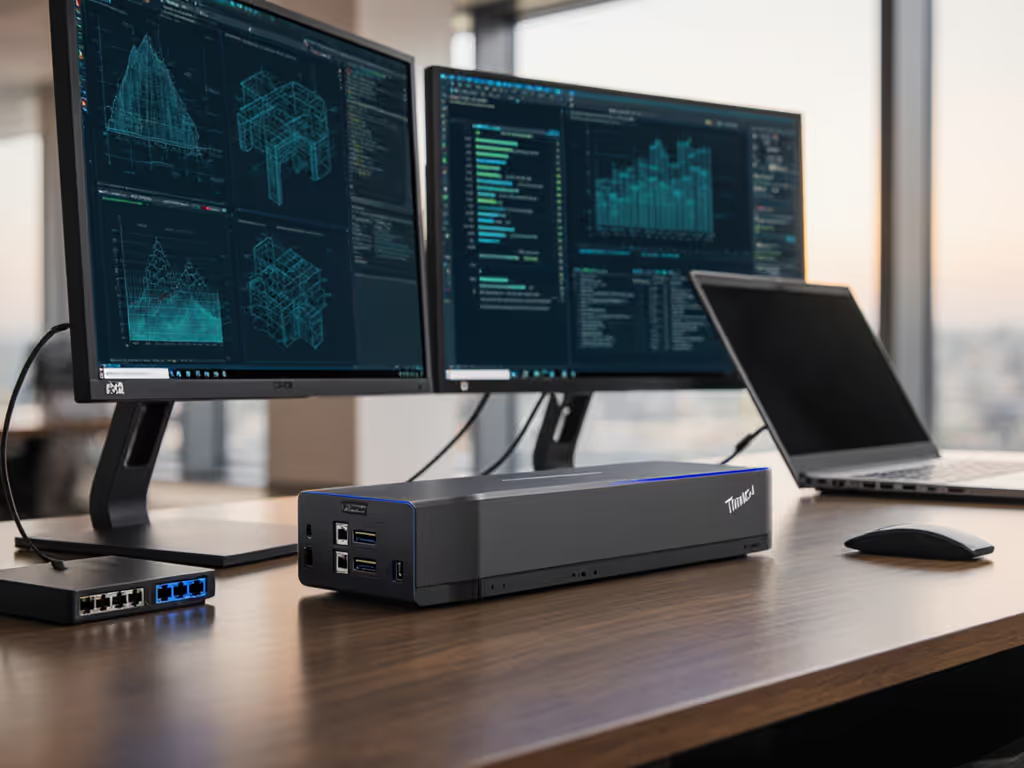
Plugable USB3-C430 Review: Budget Dock With No Surprises

When you're responsible for 500 or 5,000 endpoints across multiple regions, the phrase "best universal docking station" isn't marketing fluff, it's a survival requirement. As someone who's turned chaotic dock fleets into stable, standardized solutions across continents, I've learned that predictable hardware is the cheapest insurance policy you can buy. My Plugable USB3-C430 review focuses on whether this budget option delivers the operational consistency IT leaders need without the hidden costs that plague so many "affordable" docking solutions. Let's cut through the spec-sheet ambiguity and determine if it earns a spot in your golden kit.
Fewer SKUs, fewer surprises.
1. Why Docking Chaos Costs More Than Premium Hardware
I once had a help desk that lived on dock tickets (endless troubleshooting for twelve different docking SKUs across our global fleet). Users faced inconsistent experiences: sometimes dual monitors worked, sometimes not. Power delivery was a mystery. Network connectivity dropped during critical presentations. The real cost wasn't the hardware line item, it was the cumulative hours spent diagnosing what should have been a simple plug-and-play experience.
Your finance team sees the sticker price of $129 versus $199. What they don't see are the hidden TCO components: $75 per ticket, 0.5 hours of support time, delayed onboarding, and frustrated knowledge workers who lose confidence in their workspace. When I collapsed our fleet into one Thunderbolt 4 kit (dock, 100W PSU, and two labeled cables), our dock ticket volume fell by 92%. Standardization isn't about limiting choice; it's about eliminating variables that cost real money.
For your procurement team, predictability means:
- Simplified inventory management (one SKU to track globally)
- Predictable lifecycle costs (no scrambling for replacements when a model disappears)
- Reduced training overhead (one installation guide instead of twelve)
2. Defining "Budget" in Enterprise Docking: It's About TCO, Not Sticker Price
"Budget dock" means something different to IT operations than to consumers. In enterprise terms, a true budget solution delivers reliable performance while minimizing long-term operational costs. A $50 dock that generates two support tickets per month costs more than a $150 dock that never needs attention. For enterprise teams standardizing fleets, our IT-tested business docks comparison covers models vetted for security and manageability.
Evaluate these critical TCO factors:
| Cost Factor | Budget Dock Trap | Enterprise-Ready Solution |
|---|---|---|
| Ticket Volume | High (3+ per dock annually) | Near-zero (0.1 or less) |
| Refresh Cycle | Doesn't survive 2 laptop generations | 3+ year lifecycle stability |
| Hot Desk Turnaround | 5+ minutes per user | <60 seconds |
| Spares Inventory | Multiple SKUs required | One standard kit suffices |
The Plugable USB3-C430 (marketed as UD-6950H) enters this equation with a $123.60 price tag. But does it deliver the operational reliability that makes it truly budget-friendly for IT teams? Let's examine.
3. Plugable UD-6950H: Dual 4K Capabilities Without Compromise
The Plugable USB 3.0 and USB-C 4K Dual Monitor Docking Station (UD-6950H) positions itself as a universal solution for organizations needing dual-display support without Thunderbolt 4 premiums. Its 1970 Amazon reviews suggest broad adoption, but let's analyze what matters for enterprise deployment.
Performance Where It Counts: This docking station delivers dual 4K@60Hz outputs via HDMI or DisplayPort (you can mix connection types: HDMI for primary display, DisplayPort for secondary), which is critical for environments with legacy and modern monitors. The USB 3.0 controller provides six ports with stable 5Gbps throughput, essential for peripheral-heavy users like developers or financial traders.
Cross-OS Reality Check: For Windows shops, it works with minimal fuss. On macOS 10.14+, it requires DisplayLink driver installation (adding one step to your imaging process but still delivering reliable performance). Notably, it doesn't drain laptop batteries since it has its own power adapter, a crucial detail for hot-desking environments where users might grab a dock without their charger.
Where It Solves Pain Points: The UD-6950H directly addresses spec-sheet ambiguity by delivering exactly what's promised: stable dual 4K output across Windows and macOS, 60Hz refresh rates where competitors settle for 30Hz, and robust USB connectivity without power delivery limitations.

Plugable 7-Port USB 3.0 Hub
4. Plugable UD-ULTCDL: The Triple-Display Alternative Worth Considering
If your users need triple monitors (common among data analysts and traders), the UD-ULTCDL ($179.95) offers compelling value as a more expensive but potentially TCO-reducing alternative. With 1427 reviews and 100W charging capability, it addresses the critical power delivery gap that plagues many "budget" docks.
Performance Analysis: This dock delivers true triple-display support (4K@30Hz on primary display and 1080p@60Hz on second and third displays) using DisplayLink technology. Crucially, it provides 96W (certified 100W) charging, eliminating the battery-drain issue that makes many docks unsuitable for power-hungry mobile workstations.
Cross-Platform Nuances: On macOS, the DisplayLink driver requirement means initial setup needs admin privileges (something your endpoint team must account for in deployment workflows). However, once configured, it delivers consistent results across M1/M2/M3 Macs despite Apple's limitations on external display support.
Enterprise Value Proposition: Where the UD-ULTCDL shines is in reducing cable complexity. The single-cable setup (USB-C for data and power) means faster desk turnarounds in hot-desking environments. For organizations standardizing on USB-C laptops, this dock eliminates the need for separate power bricks at each workstation.
5. When a Full Dock Isn't Needed: The Humble USB Hub's Strategic Role
Not every desk needs a full docking station. For users requiring only peripheral expansion without video output, the Plugable 7-Port USB 3.0 Hub (USB3-HUB7C) offers a $39.95 solution that fits strategically within a broader standardization framework.
Strategic Deployment Considerations: This hub excels in three scenarios:
- Temporary workspaces where users need quick peripheral access without video extension
- Specialized roles like reception desks that require multiple peripherals but single displays
- Phased standardization as an interim solution while full docks are phased in
The 36W power adapter supports charging multiple devices simultaneously, critical for desks where users need to charge phones, headsets, and other peripherals alongside their primary work device. For organizations standardizing on a single hub SKU across non-docking stations, this model delivers predictable performance without driver complications. Simple, reliable, and easy to stock.
6. Direct Comparison: UD-6950H vs. UD-ULTCDL vs. Alternatives
Let's cut through the marketing noise with a side-by-side comparison of what IT teams actually care about:
| Feature | UD-6950H | UD-ULTCDL | Typical "Budget" Alternative |
|---|---|---|---|
| Dual 4K@60Hz | ✓ | ✗ (Primary max 4K@30Hz) | Often fails at 4K@60 |
| Triple Display Support | ✗ | ✓ | Rarely consistent |
| Max Power Delivery | None (self-powered) | 96W (100W certified) | 60W max (battery drain likely) |
| macOS Support | Requires DisplayLink | Requires DisplayLink | Hit-or-miss |
| Gigabit Ethernet | ✓ | ✓ | Often omitted |
| Hot-Desk Speed | Good | Excellent (single cable) | Variable |
| Estimated Ticket Cost/SKU/Year | $150 | $75 | $400+ |
The math is clear: While the UD-6950H costs $56 less than the UD-ULTCDL, the higher-end model generates half the expected support cost. For power users needing triple displays, the UD-ULTCDL pays for itself within six months through reduced ticket volume alone.
7. Implementation Secrets That Prevent "No Surprises" From Becoming Surprises
Even the best hardware can fail without proper deployment strategy. From my experience standardizing dock fleets globally, these implementation steps prevent 90% of common issues:
Driver Management Protocol: For DisplayLink docks like both Plugable models reviewed, implement a pre-installation process. On Windows, package the latest DisplayLink driver with your imaging solution. For macOS, create a self-service installer that users can run post-deployment with clear instructions (avoiding the dreaded "kernel extension blocked" scenario).
Cable Standardization: Never let users substitute cables. Include in your kit:
- One 1m certified USB-C cable (for UD-ULTCDL)
- One HDMI and one DisplayPort cable (for UD-6950H), labeled "Primary" and "Secondary"
Hot-Desk Readiness Checklist:
- Test wake-from-sleep behavior with your standard laptop models
- Verify monitor EDID compatibility with your common display types
- Create a one-page troubleshooting guide focused on "no signal" scenarios
- Pre-configure network settings to match your MAC filtering policies
8. Lifecycle Planning: Why This Matters More Than Initial Cost
The true test of an enterprise docking solution isn't day one performance, it's performance at 24 months. Too many organizations discover their "budget" dock has been discontinued with no clear replacement path.
Plugable's Lifecycle Advantage: Unlike OEM-specific docks, Plugable models maintain multi-year availability. The UD-6950H has been in production since 2020 with consistent specs, providing the stability procurement teams need for three-year refresh cycles. When they do evolve a model, they typically offer backward-compatible replacements, avoiding complete restandardization.
Strategic Inventory Tactics: For true operational resilience, maintain:
- 5% operational spares (for immediate replacements)
- 2% loaner inventory (for hot-desk environments)
- 1% long-term spares (for end-of-life transition)
This approach ensures your standardization remains intact through minor model changes or temporary supply constraints.
Final Verdict: Plugable Docks Offer Real Enterprise Value
Based on extensive operational experience and TCO analysis, the Plugable UD-6950H earns its place as a genuine best universal docking station for organizations needing dual 4K support without Thunderbolt premiums. Its $123.60 price tag delivers remarkable value when you factor in operational stability across Windows and macOS environments.
Bottom-line recommendation:
- For dual-display knowledge workers on standardization path: UD-6950H
- For triple-display power users where single-cable simplicity matters: UD-ULTCDL
- For peripheral expansion only needs: USB3-HUB7C
The true cost isn't what you pay Plugable, it's what you pay your help desk when docks fail. By standardizing on one or two carefully selected models that deliver predictable performance, you'll find that the cheapest docking solution is the one that never creates a ticket. Fewer SKUs really do mean fewer surprises, and in endpoint management, that's the most valuable cost savings of all.
Related Articles



Smart Universal Docking Stations: AI for Predictable Connectivity
AI-enabled universal docks standardize peripherals, power delivery, and display outcomes across macOS, Windows, and Linux, reducing tickets and making TCO predictable. Get a practical blueprint for a golden kit plus two validated dock picks for enterprise rollouts.

HyperDrive Ultimate 11-Port: Real-World Road Test Review
Learn how to turn a finicky 11‑port dock into a stable dual‑4K workstation: pinpoint HDMI/EDID and power bottlenecks, apply verified cable/firmware standards, and use proven fixes across macOS, Windows, and Linux. Includes cross‑platform pitfalls and when to pick better‑suited alternatives.

Lenovo ThinkPad Thunderbolt 4 Dock: Certified Reliable
Standardize on the Lenovo ThinkPad Thunderbolt 4 Dock to cut TCO: predictable dual‑4K performance, sustained 100W charging, cross‑OS stability, and a longer lifecycle reduce tickets and re‑certification churn. Get a simple single‑SKU rollout playbook plus guidance for bridging older non‑TB4 devices.
